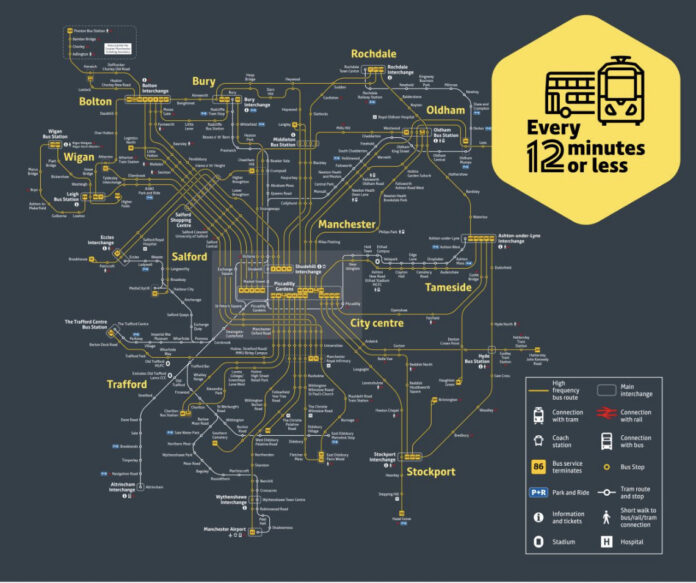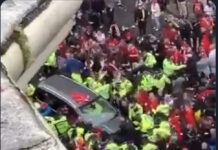The Bee Network has revealed how passengers can get around Greater Manchester by bus and tram without waiting more than 12 minutes.
With just one week to go until contactless tap and go is launched (Sunday 23rd March) in Greater Manchester, Mayor Andy Burnham has revealed a new map of ‘high frequency’ routes – where buses and trams run every 12 minutes or less on weekdays.
Shown in one place for the first time it demonstrates how, with public transport under local control, the city-region is making major progress toward a fully joined-up, regular service like in London.
More than 1.2 million people in Greater Manchester – 43.7% of the total population – live within walking or wheeling distance* of a high frequency Bee Network bus or tram service.
Since all Greater Manchester’s buses came under local control, the number of people getting on board has continued to climb. Providing higher frequency services on popular routes is vital to boost passenger numbers, as well as support economic growth, better link residents to job and education opportunities and reduce congestion.
From Sunday 23rd March, bus passengers will be able to turn up, tap and go when paying for all bus journeys. They’ll also be able to switch flexibly between bus and tram, knowing they’ll always pay the best value fare thanks to new daily and weekly caps.
Just like in London, passengers in Greater Manchester travelling on higher frequency Bee Network routes can turn up at their stop knowing that the next bus or tram is just around the corner.
Andy Burnham, Mayor of Greater Manchester, said:
“In London, passengers often simply turn up to a Tube station or bus stop knowing that they’ll be on board within minutes. Such a frequent and flexible public transport system shouldn’t be exclusive to the capital – and we promised Greater Manchester we’d deliver it with the Bee Network.
“To make that system a reality we needed to do two main things. Firstly, take back control of local buses, allowing us to set fares, routes and service frequencies to better connect our communities. We did that in January, becoming the first region in the UK to do so in 40 years.
“Next, we’re launching tap and go across bus and tram, giving people the freedom to travel in a way that works for them. One of the biggest changes we’ve introduced in Greater Manchester, it will bring us more in line with London and make public transport more convenient, flexible and affordable than it’s ever been before.
“Combine these steps with a joined-up network of high frequency bus and tram routes – within easy reach of over a million of our residents – and we’ve made major strides toward our public transport promise. Our call to the people of Greater Manchester is now to get on board and back the Bee Network so we can continue to go from strength to strength.”
The map revealed by the Mayor is intended to be the first step toward bringing more frequent, reliable Bee Network bus and tram services for people across the whole of Greater Manchester. Feedback gathered from communities through Network Reviews will be key to shaping future routes and service changes, while improvements are constantly being made to existing routes.
Developing Greater Manchester’s tram network is also essential to keeping the city-region moving and the economy growing, and work is ongoing to explore opportunities to bring Metrolink to even more parts of the city-region currently not served by tram.
Bee Network buses
There are 41 high frequency bus routes across Greater Manchester, and despite accounting for just 7% of all Bee Network services, they carry the majority of bus passengers. Of the 13.8 million journeys made by bus in February, 7.4 million (54%) were on these routes.
Out of around 577 Bee Network services in operation, the 192, 143 and 43 high frequency services account for 10% of all bus journeys taken in Greater Manchester, with a quarter of all bus trips being taken on the top 10 high frequency services.
Bee Network trams
On Metrolink, all trams run on a standard 12-minute frequency on weekdays from 6am until midnight. Higher frequency trams serving the city centre, Altrincham, Bury, East Didsbury, Etihad Stadium, Oldham Town Centre and Salford Quays run every six minutes.
During peak times at Deansgate-Castlefield, there are 40 trams per direction every hour, with a tram departing every 45 seconds. The largest light-rail network in the UK, Metrolink carries around 1.8 million people every month, and last year it set a record for the number of journeys taken by tram with 45.6 million trips in 2024.







